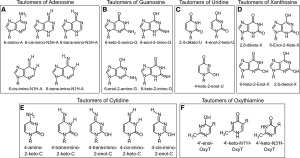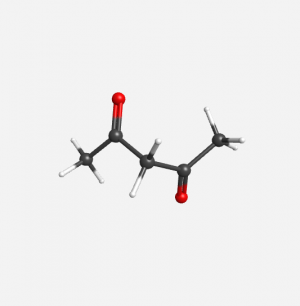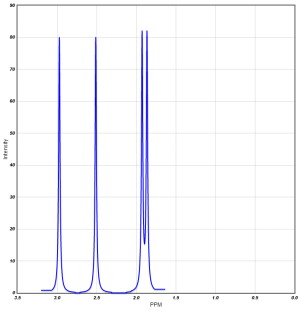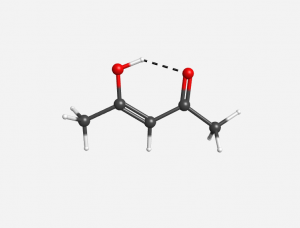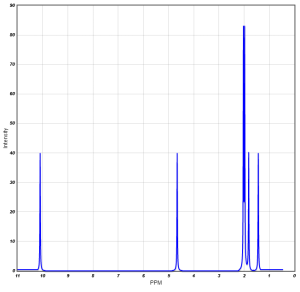Difference between revisions of "Hannah"
Jump to navigation
Jump to search
| (26 intermediate revisions by the same user not shown) | |||
| Line 1: | Line 1: | ||
| − | = | + | ==Introduction== |
| − | |||
| − | + | Based on Experiment 44: NMR determination of keto-enol equilibrium constants p522 | |
| − | Enol = alcohol | + | Shoemaker, D. P., Garland, C. W., & Nibler, J. W. (1989). Experiments in physical chemistry (5. ed). McGraw Hill. |
| − | :may also be referred to as an alkenol | + | |
| − | == | + | ===Tautomers of Acetylacetone (C<sub>5</sub>H<sub>8</sub>O<sub>2</sub>)=== |
| − | + | ||
| + | :* Keto = ketone | ||
| + | |||
| + | :* Enol = alcohol | ||
| + | ::-may also be referred to as an alkenol | ||
| + | |||
| + | :* Usually the keto tautomer is favored | ||
| + | |||
| + | {| | ||
| + | |[[File:tautomerism.png|thumbnail|Figure 1:Basic reaction of keto- and enol- acetylacetone]] | ||
| + | |} | ||
| + | |||
| + | ===Why Tautomerization Matters=== | ||
| + | |||
| + | :* Different solvents may change the equilibrium of the keto- and enol- forms | ||
| + | |||
| + | ::-Keto/enol equilibrium can be determined using proton NMR, as the spectra are different enough to distinguish between the tautomers | ||
| + | |||
| + | :* Tautomers in DNA replication have been hypothesized to contribute to mutagenic mispairings | ||
| + | |||
| + | :* "whereas in RNA, minor tautomeric forms have been proposed to enhance the structural and functional diversity of RNA enzymes and aptamers" (https://rnajournal.cshlp.org/content/21/1/1.full.html) | ||
| − | [[File: | + | {| |
| + | |[[File:F1.large.jpg|thumbnail|Figure 2: Tautomers of nucleic acid bases]] | ||
| + | |} | ||
| − | + | ==WebMO== | |
| − | : | + | :*All calculations were done using HF/6-31G(d) for geometry optimization |
| − | : | + | :*The products of the geometry optimizations were used to calculate the NMR spectra using the same basis sets |
| − | + | ==Keto Acetylacetone== | |
| + | {| | ||
| + | |[[File:molecule (2).png|thumbnail|Figure 3: 3D structure of keto-acetylacetone]] | ||
| + | |} | ||
| − | Proton NMR | + | Proton NMR |
| − | + | {| | |
| + | |[[File:nmrKetoZoomed.png|thumbnail|Figure 4: Proton NMR for keto-acetylacetone]] | ||
| + | |} | ||
| − | [[File: | + | Proton NMR shifts:[[:File:NMR-Chemical-Shift-PPM-Range-and-Values-Table-.png]] |
==Enol Acetylacetone== | ==Enol Acetylacetone== | ||
| + | {| | ||
| + | |[[File:molecule.png|thumbnail| Figure 5: 3D structure of enol-acetylacetone]] | ||
| + | |} | ||
| − | [[File: | + | Proton NMR |
| + | {| | ||
| + | |[[File:nmrEnol2.png|thumbnail| Figure 6: Proton NMR of enol-acetylacetone]] | ||
| + | |} | ||
| − | Proton NMR | + | Proton NMR shifts:[[:File:NMR-Chemical-Shift-PPM-Range-and-Values-Table-.png]] |
| − | |||
| − | + | N.B. Hydrogen bonding deshields the proton, further increasing the chemical shift | |
Latest revision as of 17:36, 5 May 2021
Introduction
Based on Experiment 44: NMR determination of keto-enol equilibrium constants p522
Shoemaker, D. P., Garland, C. W., & Nibler, J. W. (1989). Experiments in physical chemistry (5. ed). McGraw Hill.
Tautomers of Acetylacetone (C5H8O2)
- Keto = ketone
- Enol = alcohol
- -may also be referred to as an alkenol
- Usually the keto tautomer is favored
Why Tautomerization Matters
- Different solvents may change the equilibrium of the keto- and enol- forms
- -Keto/enol equilibrium can be determined using proton NMR, as the spectra are different enough to distinguish between the tautomers
- Tautomers in DNA replication have been hypothesized to contribute to mutagenic mispairings
- "whereas in RNA, minor tautomeric forms have been proposed to enhance the structural and functional diversity of RNA enzymes and aptamers" (https://rnajournal.cshlp.org/content/21/1/1.full.html)
WebMO
- All calculations were done using HF/6-31G(d) for geometry optimization
- The products of the geometry optimizations were used to calculate the NMR spectra using the same basis sets
Keto Acetylacetone
Proton NMR
Proton NMR shifts:File:NMR-Chemical-Shift-PPM-Range-and-Values-Table-.png
Enol Acetylacetone
Proton NMR
Proton NMR shifts:File:NMR-Chemical-Shift-PPM-Range-and-Values-Table-.png
N.B. Hydrogen bonding deshields the proton, further increasing the chemical shift

